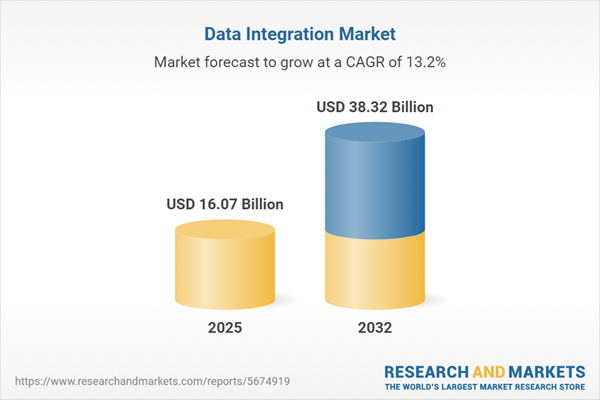Speak directly to the analyst to clarify any post sales queries you may have.
Effective data integration has become essential for organizations striving to unlock agility, innovation, and sustained value across complex technology landscapes. The Data Integration Market continues to evolve, shaped by digital transformation, compliance needs, and rapid advances in AI and cloud computing.
Market Snapshot: Data Integration Market Overview
The Data Integration Market grew from USD 14.17 billion in 2024 to USD 16.07 billion in 2025, and is projected to expand at a CAGR of 13.24%, reaching USD 38.32 billion by 2032. This robust growth reflects enterprise demand for scalable integration frameworks that enable seamless connections across cloud, on-premises, and hybrid infrastructures. Organizations are rapidly embracing data integration to support critical business decisions, regulatory compliance, and competitive differentiation in a multi-cloud environment.
Scope & Segmentation
This report provides in-depth analysis across multiple dimensions of the data integration ecosystem, focusing on the following:
- Component: Data Quality Tools, including data cleansing, enrichment, and profiling; Integration Tools for batch and real-time integration; Master Data Management Tools covering customer data MDM, domain MDM, and multidomain MDM; Metadata Management Tools for discovery and metadata repositories.
- Deployment Mode: Cloud options (private, public), Hybrid models, and On-Premises deployments such as colocation and enterprise data centers.
- Organization Size: Large Enterprises and Small and Medium Enterprises, including micro, small, and medium entities.
- Industry Vertical: Banking and Financial Services, Capital Markets, Insurance, Government and Public Sector (federal, state, and local), Healthcare (hospitals, medical devices, pharmaceuticals), IT and Telecom (services, operators), Manufacturing (discrete and process), Retail and Consumer Goods (brick and mortar, online retail).
- Distribution Channel: Channel Partners like resellers, system integrators, value-added resellers, and direct sales.
- Region: Americas (United States, Canada, Mexico, Brazil, Argentina, Chile, Colombia, Peru), Europe/Middle East/Africa (including UK, Germany, France, Russia, Italy, Spain, Netherlands, Sweden, Poland, Switzerland, UAE, Saudi Arabia, Qatar, Turkey, Israel, South Africa, Nigeria, Egypt, Kenya), and Asia-Pacific (China, India, Japan, Australia, South Korea, Indonesia, Thailand, Malaysia, Singapore, Taiwan).
- Key Companies: Informatica LLC, IBM, Oracle Corporation, Microsoft Corporation, Talend S.A., SAP SE, SAS Institute, TIBCO Software, Denodo Technologies, MuleSoft.
Key Takeaways for Senior Decision-Makers
- Robust data integration strategies are critical as organizations transition toward more cloud, hybrid, and interoperable architectures. Flexible frameworks enable real-time and batch workflows to meet varied business and compliance needs.
- The rise of AI-driven mapping and transformation tools is accelerating time-to-value by automating schema alignment and reducing manual intervention throughout integration pipelines.
- Leading enterprises are prioritizing data quality and governance, investing in integrated metadata management solutions that enhance traceability, compliance, and downstream data utility.
- Segment-specific requirements shape technology choices, with industries such as banking and healthcare emphasizing real-time availability, regulatory alignment, and privacy-focused integration across distributed environments.
- Vendor partnerships and specialized channel partners play a pivotal role in implementation, particularly as managed and partner-led services address skills shortages and enable best-practice deployments.
Tariff Impact on Data Integration Technologies
Anticipated US tariff policies for 2025 are expected to influence the cost structure of data integration infrastructure, especially regarding server and hardware capital expenditures. Enterprises are responding by accelerating cloud migration and leveraging software-based integration services to reduce vulnerability to import-related cost pressures. Vendor supply chains are also adapting via near-shoring and alternative sourcing—a trend likely to impact contract negotiations and procurement planning throughout the forecast period.
Methodology & Data Sources
This study leverages a rigorous mixed-method approach, combining direct interviews with IT leaders and solution providers with extensive secondary research from industry publications, vendor documentation, and regulatory references. Findings were triangulated using structured questionnaires, segmentation validation, and scenario modeling, with quality controls such as data cleansing and peer review to ensure reliability and actionable insight.
Why This Report Matters
- Enables strategic evaluation and investment planning across diverse industry contexts and deployment scenarios.
- Assists IT leaders and executives in benchmarking integration maturity, optimizing legacy investments, and aligning architecture decisions with regulatory and operational priorities.
- Delivers actionable insights relevant for market expansion, risk mitigation, and technology adoption strategies.
Conclusion
The data integration market is reshaped by regulatory complexity, digital transformation, and evolving technology demands. Organizations adopting scalable, AI-enabled frameworks and flexible deployment strategies will position themselves for operational resilience and sustained value.
Additional Product Information:
- Purchase of this report includes 1 year online access with quarterly updates.
- This report can be updated on request. Please contact our Customer Experience team using the Ask a Question widget on our website.
Table of Contents
3. Executive Summary
4. Market Overview
7. Cumulative Impact of Artificial Intelligence 2025
List of Figures
Samples

LOADING...
Companies Mentioned
The key companies profiled in this Data Integration market report include:- Informatica LLC
- International Business Machines Corporation
- Oracle Corporation
- Microsoft Corporation
- Talend S.A.
- SAP SE
- SAS Institute Inc.
- TIBCO Software Inc.
- Denodo Technologies, Inc.
- MuleSoft, LLC
Table Information
| Report Attribute | Details |
|---|---|
| No. of Pages | 196 |
| Published | October 2025 |
| Forecast Period | 2025 - 2032 |
| Estimated Market Value ( USD | $ 16.07 Billion |
| Forecasted Market Value ( USD | $ 38.32 Billion |
| Compound Annual Growth Rate | 13.2% |
| Regions Covered | Global |
| No. of Companies Mentioned | 11 |









